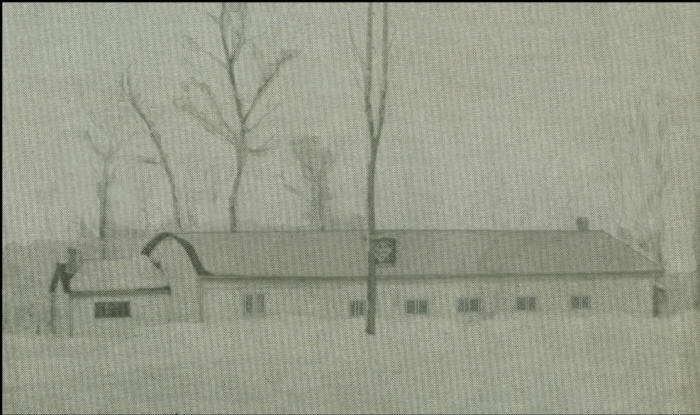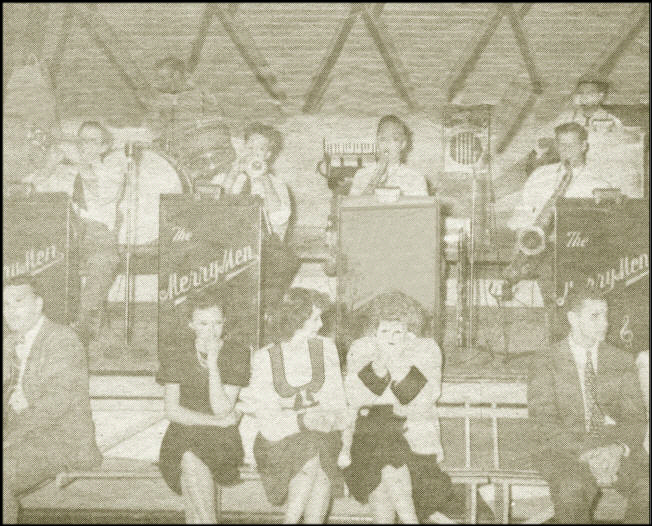|
|
|
Clark County Press, Neillsville, WI August 20, 1992, Page 36 Transcribed by Dolores (Mohr) Kenyon. Index of "Good Old Days" Articles
|
|
|
|
Clark County Press, Neillsville, WI August 20, 1992, Page 36 Transcribed by Dolores (Mohr) Kenyon. Index of "Good Old Days" Articles
|
Good Old Days
By Dee Zimmerman
The pictures in this article are faded and of poor quality. If you can supply a better scan of any of them, please contact us!
Music, dance, literature and the mastering of crafts and skills – all are a party of “The Art of Living.”
In the 1700’s thru 1800’s, many families of the Bavarian countries of Europe lived on small pieces of poor farmland. Landlords owned the large and most valuable, productive land. They lived in a form of serfdom. Music was a profession that enabled them to rise above the peasant life. An accomplishment in the arts allowed them to accomplish advancement monetarily and to “become someone.”
Without an art, the person would have no hope of advancement from the simple peasant life. The mastering of an art would set that artist apart from the other farmer, tradesman who had not mastered an art. The lords would hire the person known as an artist, before one of less accomplishment. Thus, it became an element of survival. Those people realized the skill of the arts and crafts could ensure success for them and the future generation.
Clark County’s first immigrants were of English and French descent, arriving in the mid 1800’s. The second wave of immigrants came here in the late 1800’s and early 1900’s, which were of German, Swiss, Czech-Bohemian, Slovenian, Polish and Scandinavian descent. They left their family and friends, (most, never to see them again) to go to the “land of freedom and opportunity.”
As the immigrants came west, they brought their cultures and heritage with them. They worked hard to establish their lives as farmers, tradesmen), etc. Also, they took time to enjoy some of the “Arts of Living” such as music and dancing which they had grown up with in their homeland.
Searching and reading through old publications of the County, reveals the various community halls which were used for social events. Many of the social gatherings included a dance. There would be two, three or more musicians to provide the music for dancing. The transportation of that time, limited the distance to attend the dance. So, there were many small halls, Willard had an East Side and West Side Hall. Loyal’s halls were the Woodman and M.W.A. Hall. Atwood on County “N” Riplinger, Reel’s hall and Riplinger hall, Unity hall: Granton Village hall, Pischer’s hall in the York Center area, Greenwood area had Syth’s Barn, Globe hall on 2nd floor of the store, Christie Store’s upstairs hall floor and Barton’s Barn (1 mile north of Christie). Neillsville area: – Paulson’s hall (5th and Grand), The Armory (4th & Court), Hake’s Barn (1/2 mile south of Tesmer Construction Hwy. 10 East), Riverside Pavilion, (1/2 mile from Opelt bridge), Levis Town Hall, Markwart’s barn (Highway 10 east, across from Pamida), the Stables (now Wildcat Inn), plus many more throughout the county.
In the 20’s, many families purchased automobiles. The convenience and ease of traveling longer distances brought about various changes.
During that time, four new, large ballrooms were built in Clark County within a seven or eight year time period. What these ballrooms all shared in common and of most importance were the dance floors.
The ballrooms floor joist were placed at least two feet above the ground with ends setting on concrete footings. The two foot space under the floor joists enabled air to circulate, so that moisture and humidity wouldn’t collect to warp the floor above it. The X-effect bridging between the joists gave support, resilience, and rigidity to the floor structure. The floors were 2 ˝ inch width hardwood maple boards. Boards were tongue and grooved, nailed on 45° angle at right hand ends. Nails were driven into the joists, so nail heads weren’t exposed on the floor’s surface. The floor was sanded until smooth. The smooth flexible floors provided hours of tireless dancing.
When someone would sit on the bench along the side of the dance floor during the hop polka, that person could see and feel the floor vibrate. The floor filled with dancers all dancing in time with the music, came down on the floor at the same time which caused the floor to give with their weight.
Colby Park (off Highway 13) northeast of the City was started in 1912. It was a popular place for 4th of July celebrations and baseball games. Herman and Anna Wiedenhoeft started the park and later built a ballroom on the property also. The Wiedenhoefts sold the business to Bernie and Goldie Walter in 1944, who were owners for ten years.
The Colby Park and ballroom was a popular recreation area for that community for a number of years. Other owners during its existence were LeRoy Thede and Alvin Brock.
Fire destroyed the ballroom in 1974. The Mile-A-Way Ballrooom was located one mile north of Thorp. It was built in 1926 along the east side of Highway 73. Ed Durango and Ed Zurada were the first owners. The next owner/operator was Frank Andruskiewicz. Leon Pavlok took over the business in 1944 and had it for eight years before selling the business. Various other owner names were Arneson, Johnson, Zurokowski, Razaborski, Pepersidas and Turene.
In the early 1970’s the Mile-A-Way was razed by fire, another landmark of activity to become history.
The following paragraphs are the memoirs of, and written by Elaine (Jackson) Zilk about another popular Clark County Ballroom: Merry Ol’ Gardens or Jackson’s dance hall was built in 1930 on Highway 73, seven miles north of Greenwood, five miles south of Withee in the center of Clark County and was the only dance hall for miles around. It was built by Adolph and Adeline Jackson of lumber cut from, their own farmland.
|
|
The logs cut down from the land, which were sawed into lumber used in building the Merry Ol’ Gardens ballroom.
The hall had an excellent floor for dancing and Mr. Jackson took good care of it never allowing liquids on it. A sawing crew from Thorp to saw all the lumber needed. This crew was headed by Ross Butterfield.
 |
Merry Ol’ Gardens Ballroom in a winter setting as it appeared along Highway 73, seven miles north of Greenwood.
This dance hall was very popular with people all around including towns of Loyal, Greenwood, Owen, Withee, Thorp, Stanley, Curtiss and Neillsville. The orchestras hired included bands from the area and also bands from Winona such as Dale Simons and Wally Ines, Whoopee John, Lawrence Duchow, Benny Graham and an all black band from St. Paul, was a very popular and talented group from St. Paul. And don’t forget our Howie Sturtz, who also played there as a young musician.
Many people still speak of the good times they had at Merry Ol’ Gardens and it mattered little that before coming to dance that they had put in a full days work haying or plowing. These were hearty (or hardy) people who enjoyed music and dancing, and went home with a tired feeling, but a happy heart.
 |
Don Gress and the Merrymen Band at the Silver Dome in 1947 playing for Bernard and Ann Scheffer’s wedding dance. Front row (l to r): Trumpet – Bitsy Wasserberger; Trumpet – Bud Handke, Sax – Jerry Opelt, Sax – Dale Baldwin. Back row (l to r): Drummer – Bill Tuplek, Accordion – Fred Maeder (not in photo), Guitar – Don Gress. (Photo by Jim Hauge) Do you know who the three pretty young ladies are sitting in front of the band? We know who two of them are.
The hall was used for wrestling also and roller skating and was the site of many political rallies including one during which Robert Lafollette spoke.
There were wedding dances and showers and children came with parents and learned to dance at a young age.
Robert Jackson, son of he owner ran the hall for some years and also Jerry Neunfeldt of Greenwood, and after several sales of the property some years later, it burned to the ground. I am sure the memories of good times are still intact, however, and perhaps, will bring a smile to some folks who remember “Jacksons” or “Merry Ol’ Gardens.”
The only clue that there was anything there at these days is some evidence of a driveway but the land has all grown up in trees and nature has taken over, and if one looks close they may see only the corner supports of the building remaining. (Thanks to Elaine for sharing her memories of the Merry Ol’ Gardens’ days. She and her husband, Glen, are residents of Neillsville. Also, thanks to Zona Edblom, Mrs. Davis, Frank and Blanche.) (Read the “Czech Book” compiled by Pat Martin for more ethnic information.) (To be continued next week.)
¤¤¤¤¤¤¤¤¤¤¤¤¤¤¤¤¤¤¤¤¤¤¤¤¤¤¤¤¤¤¤¤¤¤
Compiled by Terry Johnson
FIFTY YEARS AGO
“Local Boys to help in Montana’s Wheat: Dick Lowe and Bob Horswill, two local high school boys, are on their way to Montana for work in the wheat fields. They left Wednesday on Dick Lowe’s motorcycle, and looked forward to 1,000 miles of travel. Their destination was Whitetail, in northeastern Montana.”
The 70th annual Clark County fair was scheduled for August 22, 23, 24 and 25. The July 30 Clark County Press announced that premium books for the fair, were ready and available at several banks in the county.
A front page story told about Samuel Hartford, the first man buried in the Pine Grove cemetery about two miles northeast of Loyal. Hartford was a veteran of the war of 1812. The inscription on a bronze plaque affixed to a large pine tree there read: “As a lad of 14, he went as a substitute for his brother-in-law that his sister and her seven little ones might not be deprived of a husband and father’s care.” Hartford was honorably discharged on September 3, 1913, and lived until August 1, 1884.
In Granton news: “The Alfred Spaete store is being remodeled. The front of the building is being fitted as a meat market; the rear is being equipped with lockers.
|
© Every submission is protected by the Digital Millennium Copyright Act of 1998.
Show your appreciation of this freely provided information by not copying it to any other site without our permission.
Become a Clark County History Buff
|
|
A site created and
maintained by the Clark County History Buffs
Webmasters: Leon Konieczny, Tanya Paschke, Janet & Stan Schwarze, James W. Sternitzky,
|